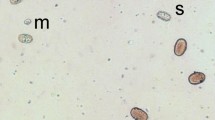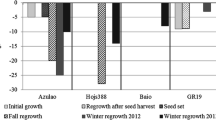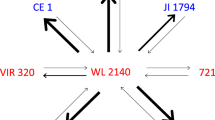Abstract
For the first time, hybrid embryos and plantlets were obtained from in vitro-pollinated whole catkins of Salix viminalis with pollen grains of Populus tremula, P. tomentosa and P. alba. Only hybrid embryos were obtained from cross S. viminalis with P. lasiocarpa. Pollen of poplar species germinated on stigmas of willow and some pollen tubes were observed growing into the ovary. After 36–48 h of pollination, several-celled globular embryos were found inside the embryo sacs. During the next 14 days in some ovules, the process of embryogenesis proceeded similarly as in the control material, that is after selfing in vitro. In some other embryo sacs embryos degenerated mainly at the globular stage. Endosperm development was poor or not present. Out of 599 catkins, which jointly included around 80.000 pistils, 141 fully developed embryos were isolated and transferred into MS medium with whole or half concentrations of macroelements. From about 65% of the cultured embryos, plantlets were established. Further investigations are in progress on finding the suitable environmental conditions for culturing plantlets in soil and establishing the hybrid characteristics of the progeny.








Similar content being viewed by others
References
Ahman I, Larsson S (1994) Genetic improvement of willow (Salix) as a source of bioenergy. Norvegian J Agric Sci 18:47–66
Ahuja MR (1986) Aspen. In: Evans DA, Sharp WR, Ammirato PV (eds) Handbook of plant cell culture, vol. 4, Techniques and applications. MacMillan, New York, pp 626–651
Ahuja MR (1993) Regeneration and germplasm in aspen-Populus. In: Ahuja MR (ed) Micropropagation of woody plants. Kluwer, Dordrecht, pp 187–194
Gullberg U (1993) Towards making willows pilot species for coppicing production. For Chron 69:721–726
Hathnaway RL (1982) Current status of willow breeding in New Zealand. Internal Report. Water and Soil Science Centre, Ministry of Works and Development, Palmerstown North, New Zealand
Krstinic A (1976) Tree breeding and silviculture of willows in Yugoslavia. Proc. 16th I.U.F.R.O. LONG. Oslo, Div 2, Project group 2.02:39–44
Lindegaard KN, Barker JHA (1997) Breeding willows for biomass. Aspects Appl Biol 49:155–162
Murashige T, Skoog F (1962) A revised medium for rapid growth and bioassays with tobacco tissue culture. Physiol Plant 15:473–497
Rönnberg-Wästljung AC, Thorsen J (1988) Inter- and intraspecific variation and genotype × site interaction in Salix alba L., S. dasyclados Wimm. and S. viminalis L. Scand J For Res 3:449–463
Stolarski M, Szczukowski S, Tworkowski J (2002) Productivity of willow clones grown as coppice on arable land in relation to harvesting frequency and planting density. Fragm Agronom 2:39–51 (in Polish)
Szczukowski S, Stolarski M, Tworkowski J, Przyborowski J, Klasa A (2004) Productivity and some morphological traits of willow coppice plants grown in short rotation on arable land. Plant Soil Envir (in press)
Szczukowski S, Tworkowski J, Klasa A, Stolarski M (2002) Productivity and chemical composition of wood tissues of short rotation willow coppice cultivated on arable land. Rostlinna Vyroba 48:413–417
Szczukowski S, Tworkowski J, Piechocki J (2001) New trends of the utilisation of willow biomass harvested from arable land to energy generation. Post Nauk Rol 6:11–19 (in Polish)
Weih M (2001) Evidence for increased sensitivity to nutrient and water stress in a fast-growing hybrid willow compared with a natural willow clone. Tree Physiol 21:1141–1148
Zavitkovski J (1979) Energy production in irrigated, intensively cultured plantations of Populus Tristis no.1 and jack pine. For Sci 25:383–392
Zenkteler M, Wojciechowicz M, Bagniewska-Zadworna A, Jeżowski S (2003) Preliminary results on studies of in vivo and in vitro sexual reproduction of Salix viminalis L. Dendrobiology 50:37–42
Zsuffa L (1990) Genetic improvement of willows for energy plantations. Biomass 22:35–47
Author information
Authors and Affiliations
Corresponding author
Rights and permissions
About this article
Cite this article
Zenkteler, M., Wojciechowicz, M., Bagniewska-Zadworna, A. et al. Intergeneric crossability studies on obtaining hybrids between Salix viminalis and four Populus species. Trees 19, 638–643 (2005). https://doi.org/10.1007/s00468-005-0427-2
Received:
Accepted:
Published:
Issue Date:
DOI: https://doi.org/10.1007/s00468-005-0427-2




